Everyone who’s anyone in the car business wants in on the diesel hatchback class. Among the most hotly contested segments in our market, diesel hatchbacks, despite the comeback of petrol, are still easy to sell and usually with a fat profit margin. And, fundamentally, there’s no denying the attraction of diesel. Fuel economy and running costs are generally stellar, and small diesel cars are getting more and more refined. The engines are now intrinsically smoother and less noisy, so fewer vibrations are making it through to the cabin.
The new entrant in this class is Ford’s exciting new Figo, a car that gets an all-new chassis, a new suspension and a big cabin. Ford, importantly, has also thoroughly updated its TDCi diesel. First introduced under the hood of the Fiesta, power for the Figo as a result is now up from 68bhp to a substantial 98.96bhp.
To keep this big, affordable diesel company, we’ve brought forward another large-on-the-inside and quite affordable diesel hatch – Tata’s Bolt. Possibly one of the most underrated cars in our market today, the fresh-looking Bolt comes with an attractive, well-appointed interior, a 74bhp version of Fiat’s 1.3 Multijet diesel and a distinctly un-Tata-like build. And the car is well kitted out, with features like a colour touchscreen and dual airbags.
The other car we’ve drawn into this comparison is Hyundai’s also-big-on-the-inside Grand i10. Built on a platform stretched especially for Indian customers, the Grand has a beautifully built interior and comes loaded with high-quality bits. It only gets a three-cylinder 1.1-litre diesel and that limits power to 70bhp – and what it loses out on in outright grunt, it makes up for in instant power delivery.
But which car has the edge among the three, and which is the best buy? Let’s get stuck right in.
Static Test
The Figo is the newest car here, and though it looks familiar, it’s attractive. The Aston Martin-like nose works really well, even on a hatchback, and the dimensions are neat and compact, with no unnecessary styling details. There is a nice ridge that runs all the way round from the headlights, but apart from that, the shape from the rear is generic; and a touch dull. Also, the 14-inch wheels look too small for the bulk of the body. The Figo, however, is easily the best-built car here. It has a toughness none of the other cars in its class can match and the solid thunk with which the doors shut is pretty special too.
Hyundai’s Grand i10 is a hatch that is also attractive. The design is defined by the large hexagonal air inlet in the lower half of the bumper and Hyundai’s designers have done a good job incorporating the narrow upper grille and headlights neatly in the nose.
The Bolt is also attractive. It may have started life as the Vista, but apart from sharing basic dimensions, this car is all new. Similar-looking to the Zest compact sedan, it features a boldly executed grille and headlight combo, a ‘floating’ roof (created by blacking out the C-pillar) and new tail-lights. And the new chrome bar between the tail-lights gives the wide rear some much-needed definition. Like most Tata cars, however, it does look ‘jacked up’, with considerable ‘air’ between the wheels and the wheel arch.

Size the cars up and it is the Hyundai that is the shortest in length, the Bolt that’s the heaviest and the Ford that’s the biggest. The Figo is also the longest at 3,886mm and it has the longest wheelbase at 2,491mm as well. But surprisingly, it is the lightest too.
The Ford also has plenty of space on the inside. While the Bolt feels wider at the front, and the Hyundai has a fraction more legroom, it is the Figo’s cabin that scores well on all fronts when it comes to interior space. You are sat a bit low at the back, especially compared to the Bolt, and the seats in general are soft, but otherwise, the rear is a perfectly agreeable place to be in. Unlike the other two, however, the Figo lacks adjustable rear headrests, and that means rear seat passengers lack whiplash protection for their necks. Bad. Front passengers, however, have it good when it comes to safety, with twin airbags on all but the base variant.
It’s the Bolt that allows rear seat passengers to slip into and out of the car with the greatest ease. Seat height and thigh support are better than on the Ford, and while the rear seat is a bit flat, comfort levels are extremely good as the seat’s rake is just right. The front seats are generous too, but firmer cushioning, especially in the lower back area, would be welcome.
The Grand i10’s cabin might be the narrowest, but legroom at the rear is the most due to the extra 40mm that has been added to the wheelbase. The backrest, however, is a bit too reclined, the seat base or squab isn’t that generous and you sit a touch low, which is accentuated by the high window line. The Hyundai, however, does get rear air-con vents, not on the competition.
Where the Grand i10 excels is in the quality and ambience of its cabin. Quality levels are a clear step up from the Ford and Tata, and attention to detail is so good, levels are not that much better on even its elder sibling, the Elite i20. The assault on the senses starts with the quality of the leather-wrapped steering wheel with its beautifully built buttons, and Hyundai has also made sure that everything you touch – knobs, buttons, gear lever and handbrake – have a distinctly premium feel. The buttons are well-damped and all the rotary knobs are treated with a premium knurled finish that further adds a touch of class to the cabin. Hyundai sells an almost identical short wheelbase version of this car in Europe, and the elevated levels of quality for that market shine through. Even the beige used for the dash looks great. The front seats are comfortable and offer good lateral support, although the seat base seems a bit flat.

The Figo’s and Bolt’s dashboards are clearly a step down in comparison. The Ford certainly has the toughest build, which seems good to last the better part of a decade. Its silver centre console and nicely designed EcoSport-type steering wheel work well with the wide centre console. Other bits like the knurled metallic climate control knobs and the easy connectivity via Ford Sync System, also found on the EcoSport, make the Figo cabin experience pleasant. But there are plenty of hard plastics, the interiors are a mass of grey and the front seats, though large, are a bit too soft.
The Bolt’s dash looks more attractive, and with its colour touchscreen, it is well-equipped in comparison too. Quality levels in many places are better than those on the Ford and though the odd seam and joint is out of place, the overall ambience of the cabin is quite good. The new steering and centre console feature tastefully executed ‘metallic’ inserts, and there’s some chrome piping around the vents and gear lever. While the driving position on the Ford is better, visibility from the Tata cabin is a bit superior.

The Bolt’s centre console, however, has almost no stowage. The single cupholder is too shallow to even hold your phone securely and the door pockets are narrow and impractical. The Ford has a massive glove box, space for a pair of bottles in each front door and the centre console behind the gear lever has half a dozen or so cubby holes. Hyundai’s Grand i10 is also quite practical. You get one-litre bottle holders in each of the doors, two large cup-holders behind the gear lever and
a cubbyhole for storing your phone just below the air-con controls.
The Ford has the biggest boot at 257 litres, but the i10 isn’t too far behind at 256 litres. The Bolt gets only 210 litres.
Dynamic Performance
With diesel cars, you expect to sacrifice a bit of performance. And that’s especially true when it comes to hatchbacks at the lower end of the price table. Thing is, with the new Figo diesel, this is a notion that goes flying out of the window. To begin with, it has the most favorable power to weight ratio of any car here. It is the lightest at 1,041kg and it makes the most power, with a strong 98.96bhp being put out by the thoroughly updated motor. Then, though there is a bit of clatter at idle, it smoothens up once you are past 2,500rpm and turns almost petrol-like. The best bit is that the punch from the motor is also massive. Drive the Ford with a bit of verve and it will leave the line tyres smoking, wheels spinning. The surge from the turbo really comes on strong after around 2,000rpm, and then there’s a firm push in the back all the way to 4,000rpm. And, unlike most diesels, the faster you wind the motor, the happier it feels. It does begin to strain a bit after 4,200rpm, but by that time, the motor has put out so much grunt, you are already enjoying yourself thoroughly. The clutch is slightly heavy and the gearbox needs some effort, but keep your right foot pinned, push the gears through at the right time and the new Figo will fly past the 100 mark in just 10.5 seconds. That’s very quick for a diesel hatch – comfortably faster than any of its direct competition and quicker than even the diesel Polo GT. Keen drivers will find this performance all but irresistible. And it’s even nice at city speeds. The turbo comes in early at around 1,600rpm and this allows you to stay in a higher gear for a more relaxed driving experience. There is a bit of turbo lag though, and the Ford unit does get a bit noisy at high rpm.
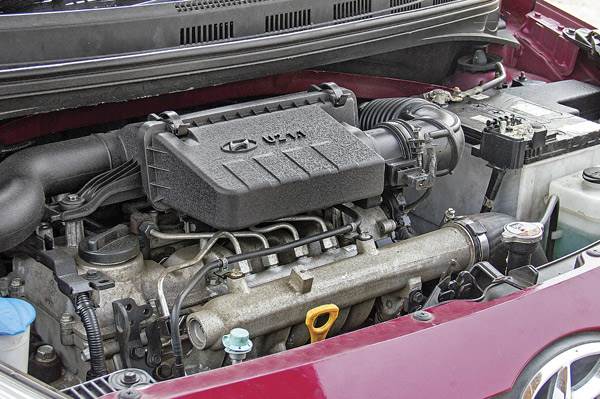
The Hyundai may not have much outright performance and grunt, but is perfectly suitable for city driving, despite the fact that it displaces only 1100cc and has a three-cylinder engine. As expected, there is some vibration at low engine speeds. But a small dab on the accelerator is all it takes to get the counter rotating balancer shafts up to speed, and that smoothens out the offbeat pitter-patter at idle. Power delivery is instantaneous, extremely linear, and the responsiveness is so good, you are happy to shift up early. The short throw gearbox is another delight – it’s light and superbly accurate, the clutch engages and disengages without a lurch and that makes it a great city car. Past 3,500rpm, the engine rapidly loses steam and there’s quite a discordant thrash from under the bonnet. Overtaking on a highway needs some amount of forward planning and at times can be frustrating. It’s to be expected, the Grand i10 takes a leisurely 20.25 seconds to get to 100kph – it’s almost a full 10 seconds slower than the Ford!
The Bolt’s 74bhp isn’t much higher, but the manner in which the Fiat-based engine makes power helps it deliver much more performance. Like all Multijet engines, it is a bit clattery at idle and there’s a fair amount of lag till around 1,800rpm, but after that, it’s smooth sailing to 4,000rpm. And power delivery is good too. The engine responds well to the accelerator, there’s a nice spike of power around 2,200rpm, and an increase in engine speed also gets a corresponding increase in power as you wind the engine harder. Revving it past 4,500rpm, however, is pointless. The motor will climb up to 5,000rpm and a bit beyond, but there’s very little to be gained in terms of power, and it gets very noisy as well. Zero to 100 takes considerably longer than the Figo at 16.58 seconds, but performance is good enough even for highway use. And what makes the experience nicer is the light and easy-to-slot gear lever.
The Bolt is also the car that has the best ride here. There’s plenty of wheel travel, and the supple springs and well-tuned dampers help on really rough patches. They allow the Bolt to suitably mask the severity of most potholes and the suspension works silently too. There is some amount of movement from the body and larger holes register as clunks, but overall ride is very good.
The Ford rides well for the most part too. There’s a degree of suppleness present when the car goes over most regular undulations, and even primary ride on longer undulation is good. Larger bumps, however, register with more of a thud, and at slow speeds on an uneven surface, the Figo feels a bit stiff-kneed. So while the ride comfort of the Figo is good, it can’t match the Bolt and is nowhere near as good as a Ford should be.
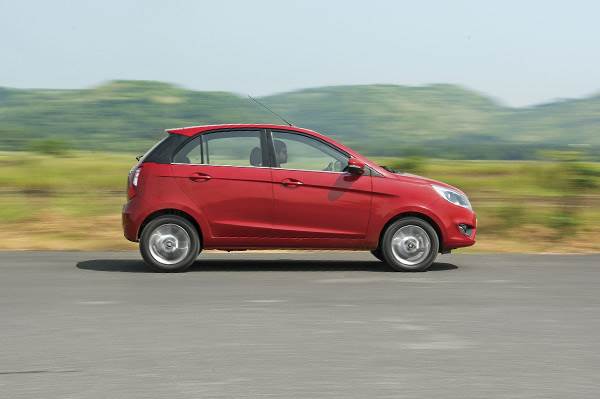
The Hyundai also should have been more comfortable on a rough road. It is happy to ride smoothly over most small- and medium-sized bumps, but larger bumps, where more wheel travel is called for, toss it about quite a bit; and this is especially true at the rear. So, if you encounter large bumps in the Hyundai, it’s best to slow down. That said, the Grand i10 is the nicest to drive in the city. The steering is super smooth and the controls are light and precise. Drive faster and the accurate steering and good body control are initially impressive too; it’s just that the feeling of composure falls away when you really step up the pace.
The Figo, with its slightly heavier steering, isn’t as easy to drive in traffic. The clutch is a touch heavy and gear selection takes some effort too; more effort than on the Grand i10, but that’s understandable. What you do miss on the Figo is the crisp Ford handling. The Figo rolls easily in corners. The steering, which has a bit of slack around the straight-ahead position, lacks the feel and precision of the Fiesta. That means the Figo is a bit lacklustre to drive on a winding road. The brakes, however, have plenty of bite and stability in general is good.

The Bolt is the surprise package here. The steering is light and very fluid at low speeds – it helps when you need to change direction regularly in traffic. And though it rolls a fair bit, it doesn’t shy away from attacking corners with a fair amount of resolve. It’s no Swift though, so it isn’t totally at ease at speed. And the brakes feel quite wooden just when you need them the most, which leads to some panic stops.
Verdict
The Bolt is a really well-rounded package and, as things stand, possibly the most underrated car in our market. It is comfortable, well built, well equipped and nice to drive. The 1.3 Fiat-sourced diesel, however, is starting to show its age. At Rs. 7 lakh, it may seem like good value, but it’s expensive for a Tata. Concerns about resale value and even longterm reliability eventually mark it down.
The Grand i10 from Hyundai feels distinctly premium on the inside and is light and effortless – it is the most relaxed to drive in the city. It is also good value at Rs 6.77 lakh. However, it feels more than a bit underpowered when you show it an open road.
The Figo may feel a bit dumbed down from previous Fords in areas like the interiors and ride and handling, but as an overall package, it shines through. Under the very stylish exterior is a very spacious, comfortable car with a good amount of safety features, which makes the Rs 7.4 lakh price seem decent value. The cherry on top, however, is the additional power and performance from the retuned 1.5 diesel engine. You can either drive it in a relaxed manner and enjoy the effortless grunt, or wind it out and enjoy the petrol car-matching performance. Ford’s new Figo 1.5 TDCi delivers the best of both worlds, and that gives it the edge.
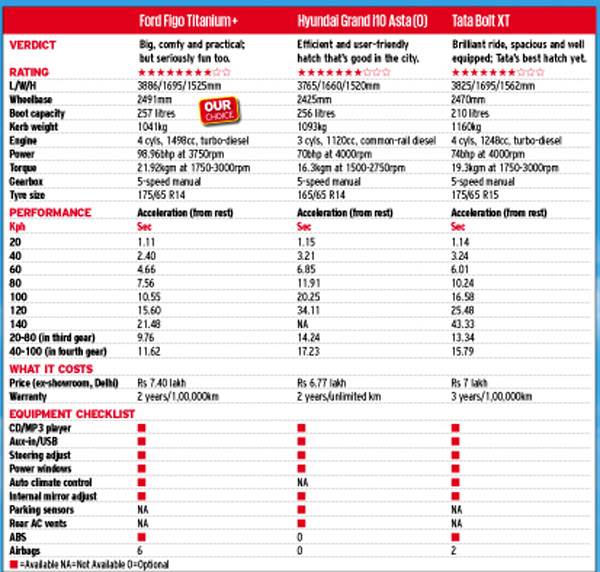

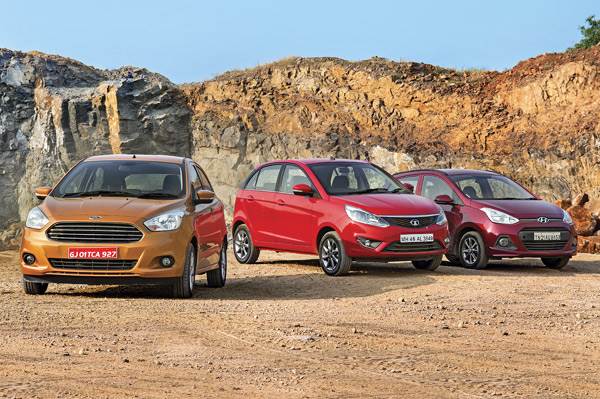
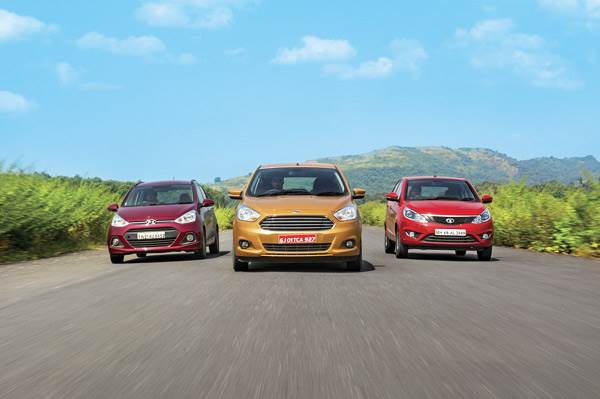




Comments
Member Login
Personal Details
No comments yet. Be the first to comment.